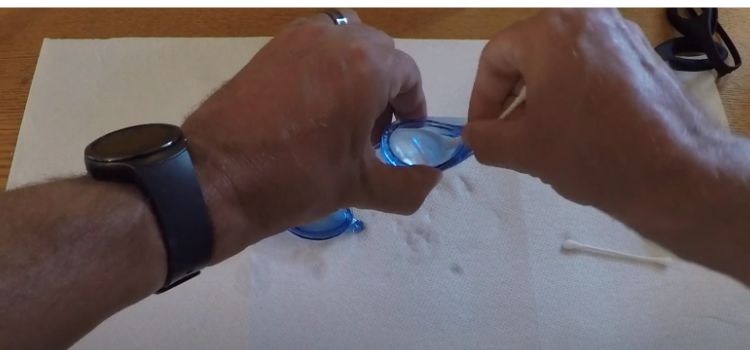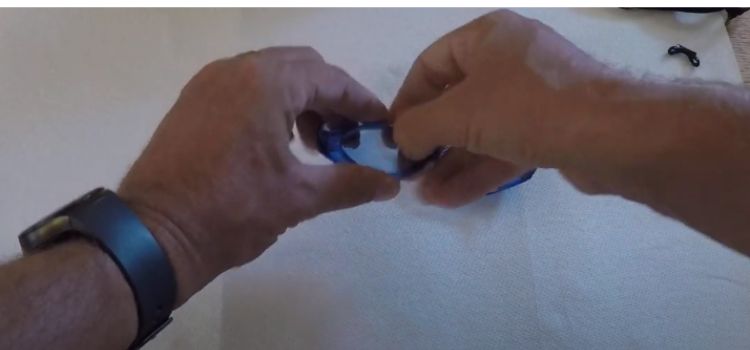As an Amazon Associate I earn from qualifying purchases.
Keeping your eyesight clear when swimming becomes easier with goggles for swimming that have an anti-fog coating. Nonetheless, there can be circumstances in which you choose to take the anti-fog coating off. Perhaps it wears unevenly and causes eyesight blurriness, or perhaps you just want to swim without it. For whatever reason, you can take off your best optical swim goggles‘ anti-fog coating, but you should proceed carefully to protect the lenses. This tutorial will go over the justifications of the procedures about how to remove anti-fog coating from swim goggles.

Why Remove the Anti-Fog Coating?
It’s crucial to comprehend the reasons behind your desire to remove the anti-fog coating from swim goggles before delving into the techniques for doing so. Anti-fog coatings, among other advantages, lessen misting and improve underwater visibility. They give the lens’s surface a hydrophilic coating that aids in the uniform distribution of water droplets and inhibits the development of fog. But in these situations, it could be advantageous to take off the anti-fog coating:
Uneven Wear:
Over time, the anti-fog coating on swim goggles may wear off unevenly. This can result in patches of fog on the lens, making it difficult to see clearly. Removing the entire coating can provide consistent visibility.
Allergic reactions:
Some individuals may have sensitivity or allergies to the substances used in anti-fog coatings. Skin or ocular discomfort may be less likely if the covering is removed.
Personal preference:
Some swimmers might like the feel of goggles without an anti-fog coating. Removing it can make the lenses more like traditional goggles.
Repairs or Alterations:
It might be required to remove the anti-fog coating if you intend to make any changes to your swimming goggles, such changing the lenses.
Methods to Remove Anti-Fog Coating

Now that we know why you might wish to get rid of the anti-fog coating, let’s examine how to do so.
Method 1: Soapy Water
This method is relatively gentle and involves using a mild soap solution to gradually break down the anti-fog coating. It’s suitable for those who want to maintain the integrity of their goggles.
Materials Required:
- Mild liquid soap (dish soap or baby shampoo)
- Warm water
- Microfiber cloth
- Freshwater
Steps:
1. Pour warm water into a sink or basin.
2. Gently stir in a little amount of liquid soap to the water. You want a soapy solution, but not overly concentrated.
3. Submerge your swim goggles in the soapy water. Ensure the lenses are fully covered.
Allow the goggles to soak for 10-15 minutes.
4. Gently rub the lenses with your fingers, using a circular motion. The anti-fog coating should start to soften and come off.
5. Rinse the goggles thoroughly with fresh water to remove the soap and any remaining anti-fog residue.
6. To dry the goggles and give the lenses a clear shine, use a microfiber towel.
7. Verify that the anti-fog coating has been entirely removed by looking at the lenses.
Method 2: Rubbing Alcohol
To remove the anti-fog coating, use rubbing alcohol. To protect the lenses, utilize this more forceful procedure carefully to prevent any damage.
Materials Required:
- Isopropyl rubbing alcohol (70% or higher concentration)
- Cotton balls or pads
- Microfiber cloth
- Freshwater
Steps:
1. Dampen a cotton ball or pad with isopropyl rubbing alcohol.
2. Gently rub the soaked cotton ball or pad on the lenses, targeting the areas with the anti-fog coating. Move in a circular motion, being cautious not to exert excessive force.
3. Keep rubbing until the layer that prevents fogging starts to come off. It might take some time.
4. Use fresh Water to thoroughly rinse the goggles in sequence to get rid of any leftovers.
5. After the goggles’ lenses have dried, polish them to a high shine with a microfiber cloth.
6. Verify that all remnants of the anti-fog coating have been eliminated by checking the lenses. If required, repeat the procedure.
Method 3: Toothpaste

Because of its abrasive qualities, toothpaste can be used to gently brush off the anti-fog layer. Use cautious when using this procedure, especially if your goggles have easily scratched or sensitive lenses.
Materials Required:
- Non-gel toothpaste (white toothpaste is preferable)
- Soft-bristle toothbrush
- Microfiber cloth
- Freshwater
Steps:
1. Apply a small amount of non-gel toothpaste to the lenses, specifically targeting the areas with the anti-fog coating.
2. Gently scrub the lenses with a soft-bristle toothbrush using a circular motion. Be very gentle to avoid scratching the lenses.
3. Continue scrubbing for 2-3 minutes or until you see the anti-fog coating starting to come off.
4. Rinse the goggles thoroughly with fresh water to remove the toothpaste.
5. For polishing the swim goggles lenses to a extreme shine after drying have to use microfiber cloth.
6. After completing all the processes have to make sure that the anti-fog coating has been completely removed.
Method 4: Acetone (Nail Polish Remover)
Strong and efficient in removing the anti-fog coating is acetone. However, you must use extreme caution to ensure that neither the lenses nor Goggle frames are broken; this should only be done as a last resort.
Materials Required:
- Acetone (nail polish remover)
- Cotton balls or pads
- Microfiber cloth
- Freshwater
Steps:
1. Dampen a cotton ball or pad with acetone.
2. Gently rub the soaked cotton ball or pad on the lenses, targeting the areas with the anti-fog coating. Use a circular motion, but be extremely gentle.
3. Continue rubbing until the anti-fog coating starts to dissolve. This should happen relatively quickly, within a minute or less.
4. Rinse the glasses thoroughly with clean no removal of water leftovers.
5. After drying the glasses, use a microfiber cloth to shine their lenses.
6. Verify that the anti-fog coating has been entirely removed from the lenses.
Important Considerations:
- Be patient and gentle when using any of these methods. Rushing or applying excessive pressure can damage the lenses.
- Always test any method on a small, inconspicuous area of the goggles first to ensure it doesn’t cause any adverse effects.
- If you have prescription swim goggles, consult your optometrist before attempting any DIY anti-fog coating removal methods, as they might affect the prescription.
- After removing the anti-fog coating, make sure your goggles are clean and free from any residues that might affect your vision.
- Once the anti-fog coating is removed, you may notice that your goggles fog up more easily. To combat this, use anti-fog sprays or other treatments designed for use with swim goggles lenses.
Tips for Maintaining Fog-Free Goggles

There are my tips to protect your swim goggles from the fog. Here we have given few tips just for helping you out.
So, please follow all the tips which have been given below:
1. Use an Anti-Fog Spray or Gel: Anti fog spray is the prevention item. If you will use it to your swim goggles then your swim goggles will be free from the fog. You must have to use it as per the direction which has been given by the manufacturer.
2. Appropriate Storage: Keep your swim goggles in a case to shield the lenses from dirt and debris.
3. Avoid Touching Lenses: Try to refrain from touching the interior of the goggles to minimize the transfer of oils and dirt that can contribute to fogging.
4. Regular Cleaning: Clean your goggles after every swim session with fresh water and a gentle, non-abrasive cloth.
5. Replacement: If your goggles become heavily scratched or the fogging persists, it may be time to invest in a new pair.
By following these instructions, you can swim sessions with clear eyesight and avoid the irritation of hazy goggles.
Conclusion:
In conclusion, removing the anti-fog coating from swimming goggles is achievable but delicate. For removing the coating just uses rubbing alcohol, toothpaste, acetone, or soapy water. Always take your time, handle the goggles gently, and make sure they’re completely clean after taking off the anti-fog coating. You may enjoy vision while diving with the right technique, whether you want glasses with or without anti-fog protection.
FAQs (Frequently Asked Questions)
A: Rubbing alcohol with at least 70% alcohol content is best.
A: Non-abrasive toothpaste is recommended to prevent scratches.
A: When done gently, the risk of damage is minimal.
A: No, the vinegar solution is safe for swim goggle lenses.
A: Only when it becomes ineffective or damaged.
A: It’s not recommended as excessive heat may damage the goggles.
Amazon and the Amazon logo are trademarks of Amazon.com, Inc, or its affiliates.
Leave a Reply